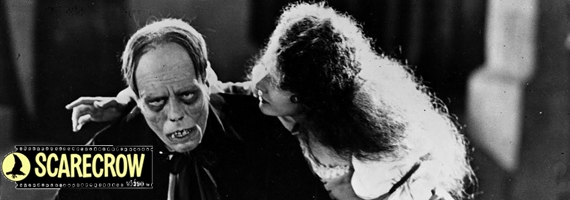
VERSUS THE SCARECROW EPISODE FOURTEEN: Shut Up!! I decided to challenge myself and really open the doors of my film knowledge and take on “The Scarecrow Video Movie Guide”. It’s 808 pages of movies and movie reviews from some of the most knowledgeable movie people you don’t know. It’s a book put together by a staff that praises, and destroys, some of our favorites and not so favorites. You can read the rest of my series here.
Just a quick refresher: each episode, I’m going to tackle three films from three different categories. Two films will be films I’ve never seen before and one will be one I’ve seen before or own. For the new films, well, new to me, I’m going to review them like a typical FTS review using the TOAST Rating system. But, for the films I’ve seen, I’m going give a quick paragraph or two about why I like or don’t like the film. We’ll try to include the poster and trailer for each film. “….and here. We. Go!”

This episode of Versus The Scarecrow is dedicated to silent film. I’ve previously reflected on the masterpiece that is Metropolis (Episode 6) but this time, I’ll be watching three silent films I have never seen before, so expect three reviews instead of the usual two and a reflection. I’ll be watching The Cabinet of Dr. Caligari (1920), The Phantom of the Opera (1925), and I’ll FINALLY get around to the quintessential silent classic Nosferatu (1922).

The Phantom of the Opera (1925) Directed by Rupert Julian. Starring: Lon Chaney, Mary Philbin, Norman Kerry. IMDB says: “A mad, disfigured composer seeks love with a lovely young opera singer.”
I was blown away by this film. I didn’t think it was possible (aside from Metropolis) to be so blown away by a silent film, but it is. The Phantom of the Opera (Phantom) reduced me to a child, being totally mesmerized by an animated film. Phantom pulled me in and didn’t let me go until it’s overly satisfying conclusion. Once I saw the words “Fin”, I was ready to stop the movie and start it over from the beginning. The performances, suitably over the top, make such a small silent film, look larger than life.
We all know what the film is about. Two guys buy a theatre. The previous owners say, hey, be mindful of the Phantom, he likes things a certain way. The new owners proceed with no regard for the Phantom. The Phantom doesn’t like that and begins to wreak havoc, first by dropping a chandelier, then abducting a young performer, then by strangling people. Yeah, you heard me, strangling people. This version is a bit darker than its latter versions with hangings, fighting, near drownings, and the face of Lon Chaney (The Phantom) It’s said that when this film was screened, moviegoers would faint or pass out upon seeing Lon Chaney’s face when the mask was removed. Now, I didn’t do that, but it definitely caught me off guard at how creepy it was.
The film’s score is outstanding. It’s a beautiful cross of orchestral music, organ music, and operatic singing. Now this threw me off when I first heard it. I had assumed that silent films had a orchestral music only soundtrack. Phantom proved me wrong by having two separate portions of the film where there was a female singing an operatic selection. It synced wonderfully with the film and really added the larger than life feel to the film. Another thing I assumed was that all silent films were black and white or monochromatic. While most silent films I’ve seen have followed this, Phantom, again, surprised me. It had scenes were things were very blue or orange or green or a gold/yellow color, but at the films mid-point, a pivotal scene was done in Technicolor. It’s during the masquerade scene where The Phantom is dressed as Red Death. It was a gorgeous scene with such spectacular visuals and incredible attention to detail. That was the scene where I knew I was watching my 2nd favorite silent film (the first being Metropolis). This is now my favorite version of The Phantom of the Opera and I cannot recommend it enough. It’s currently available through Netflix Instant Watch.


Check back tomorrow to read the conclusion of episode 14 with my reflections on Nosferatu . If you're interested in more, you can find the rest of the Versus The Scarecrow series here.

